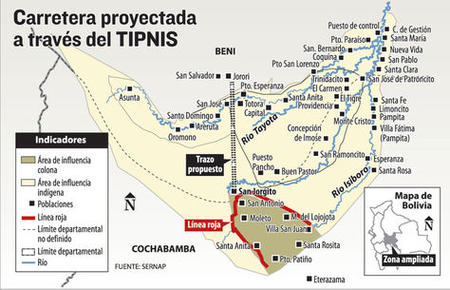McCormick, Myles. ‘They lied’: Bolivia’s untouchable Amazon lands at risk once more The Guardian. 11 Sept. 2017.
In 2011 Bolivia’s Tipnis national park was declared “untouchable” which protected the land from further development. This huge victory for the indigenous people living in the area came after months of protests in Bolivia’s capital La Paz during which protesters clashed with riot police and were subjected to tear gas, rubber bullets, and other riot control techniques. These protests were sparked by an attempt to build a road through the national park, luckily the plans to build the road were abandoned after the “untouchable” declaration.1
 2
2
On August 13th, the Bolivian president signed a bill that revoked Tipnis’s untouchable status. This could mean that the road will be built through the park after all. Roughly 14,000 people live in the Tipnis national park, most of whom are indigenous. The park is also home to a diverse animal population and some studies estimate that the construction of this new road could cause up to 64% deforestation in this national park over the next 18 years. Much of this deforestation would not come from the new road on its own but would come from the people and the development that the new road would bring with it. While the native population is concerned about the new development, the government of Bolivia argues that the construction of this road is necessary to bring support services like education and medical services to the people who live in this area. To enforce their claim the government references a 2012 study that supposedly shows that the people of the area support the construction of this road however studies by an independent third party has showed that the government study was rigged. Many people in the area are not opposed to a road however they are opposed to a road that runs through the proposed area because it would be culturally and environmentally disastrous.1
 3
3
This article actually does a good job of portraying the voice of the indigenous population of the area discussed. They include arguments from the native tribes but they also conducted interviews and used direct quotes from affected peoples. My one complaint about the portrayal of the native people in the article is that they seemed to group all of the tribes together despite the fact that they seem to have different opinions about the issue.
The article I picked relates to the the course topic of identity in Latin America because this is a common clash in Latin American countries that can challenge the identity of people, especially indigenous people. When the government tries to interfere with the Indigenous way of life, even if they are trying to help, it can erode indigenous culture and identity which can in turn erase an entire way of life.
1) https://www.theguardian.com/environment/2017/sep/11/they-lied-bolivia-untouchable-amazon-lands-tipnis-at-risk-once-more
2) https://boliviadiary.files.wordpress.com/2012/03/octava-marcha-llegada-la-paz.jpg


